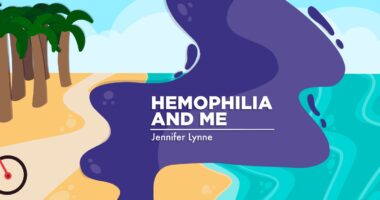Bruises Are a Routine Part of My Life With Hemophilia and VWD
Columnist Jennifer Lynne has grown accustomed to easy, unpredictable bruising

As a person with von Willebrand disease (VWD) and hemophilia, bruises have been a near-constant presence in my life.
VWD and hemophilia are bleeding disorders that affect the body’s ability to form blood clots and stop bleeding. Both can cause spontaneous and excessive bleeding, including bruising, heavy menstrual periods, and nosebleeds.
I tend to blame my bruises on VWD and not hemophilia, but I’m never sure which bleeding disorder causes which issue. One symptom of VWD is excessive bruising. People with this condition tend to have more significant bruises, and they last longer than usual.
Painful lumps under bruises are a hallmark sign of VWD. As I write, I have two impressive, colorful bruises on my knee, one with a large lump underneath. I almost always have a bruise somewhere on my body, including a permanent one seemingly tattooed around my waist from my shorts and pants.
Bruises, for me, are frustratingly unpredictable. Sometimes I have many, and I’m not sure what I did to cause them. Other times I’ll bang a limb and think, “Wow, this one is going to be huge,” but the telltale bruise never pops up.
When people notice
Sometimes people notice my bruises, which has caused some uncomfortable situations in relationships. More than one former boyfriend saw my bruises and became concerned that people would assume he was abusive. I’ve learned to reassure boyfriends that bruising, for me, is expected.
As I wrote a few weeks ago, my friend Kayla Mack lives with severe VWD. Bruises led to her diagnosis at age 2. She recently told me, “People will sometimes comment on my bruises. I will say my blood doesn’t clot well. I wear jeans when I leave the house to cover them.”
Unlike Kayla, I no longer try to cover my bruises as I get older. I accept them as a part of me. They’re my normal.
I also no longer freak out about them. In my 20s, I once visited my primary care provider because bruises were popping up out of nowhere. He humored me and ran some tests, but ultimately, my bleeding disorders caused them.
Treatment
If you have VWD or hemophilia, it’s essential to see your hematologist regularly, as treatment can help manage the symptoms and reduce the risk of excessive bleeding and bruising. Treatment for both VWD and hemophilia involves replacement therapy with missing clotting factors to help prevent bleeding episodes. Sometimes other medications may be used to increase the levels of von Willebrand factor in the blood.
The best treatment for a bruise, in my experience, is the RICE method (rest, ice, compression, elevation), with an emphasis on the ice. Be sure to check with your hematologist if you’re not sure how to treat a bruise.
Note: Hemophilia News Today is strictly a news and information website about the disease. It does not provide medical advice, diagnosis, or treatment. This content is not intended to be a substitute for professional medical advice, diagnosis, or treatment. Always seek the advice of your physician or another qualified health provider with any questions you may have regarding a medical condition. Never disregard professional medical advice or delay in seeking it because of something you have read on this website. The opinions expressed in this column are not those of Hemophilia News Today or its parent company, Bionews, and are intended to spark discussion about issues pertaining to hemophilia.








Leave a comment
Fill in the required fields to post. Your email address will not be published.